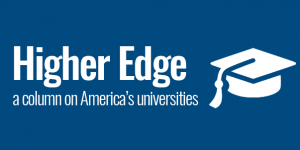In 1911, the federal government tried to rate American colleges, but failed miserably. Undeterred, the U.S. Department of Education is trying again. Later this fall, a draft of President Obama’s Postsecondary Institution Ratings System is set to be released for the 2015-2016 academic year.
Created in response to a plea from the Association of American Universities, the 1911 rankings were designed to help graduate programs assess the quality of an applicant’s undergraduate education. The proposed PIRS, however, was ultimately designed to help curb America’s skyrocketing student debt.
Unlike U.S. News rankings, which just ranked Georgetown University in a 21st place tie with Emory University, the federal system does not stack colleges against another, but rather, groups them into tiers. In the early 20th century, Kendrick Babcock, the U.S. Bureau of Education’s top higher education official, classified America’s over 600 higher educational institutions into either Class I, II, III, or IV based on preparedness for graduate-level study. In the federal rating system at that time, Georgetown was placed in the Class II tier.
When a draft of the ratings was made public in 1912, universities essentially flipped out about how the ratings would ruin their reputations, leading President Taft to issue an executive order banning them. Their reaction was no surprise considering today’s obsession with college rankings, but the difference is that in 1910, only 2.7 percent of the population had a bachelor’s degree. A century later, roughly 38.7 percent of working-age Americans (25 to 64 years old) hold a two- or four-year college degree.
Now, the potential impact of college ratings isn’t about the fame—it’s about the money.
Obama resurrected the idea of federal college ratings last August in a speech during his college affordability bus tour. “It is time to stop subsidizing schools that are not producing good results and reward schools that deliver for American students and our future,” he said.
PIRS would measure educational access, affordability, and outcomes of university graduates to determine which offer the best value, and then tie the resulting ratings directly to federal aid—thereby rewarding highly rated schools while penalizing schools in the lower tiers. Critics of the federal rating system argue that the success of some schools cannot be measured in data, particularly those with diverse specialties and those that produce graduates who pursue careers with low incomes and high societal value, such as teachers and social workers.
The nuances of exactly how PIRS would rate the 7,000-plus colleges and universities in the U.S. unclear, but its goal is clear: Americans are drowning in student debt, and as both college enrollment and tuition increase, knowing the value of your higher education is more important than ever.
In the 2011-2012 academic year, students and families borrowed more than $106 billion to pay for the cumulative $154 billion price tag of tuition and fees at higher education institutions—including for-profit schools, arguably the main target of PIRS.
On Sunday’s episode of Last Week with John Oliver, comedian John Oliver targeted for-profit colleges and universities, which he emphasized were becoming increasingly—and dangerously—popular as states slash funding for their universities and community colleges reduce capacity. Oliver noted that students at for-profit schools, meaning that they are publicly traded on Wall St., represent about 13 percent of the higher education population, yet they constitute 31 percent of all student loans and nearly 50 percent of all loan defaults.
Georgetown boasts a high price tag, but also high quality faculty and research, while for-profit universities spend roughly a quarter of their revenue on marketing while spending only an eighth of total profits on educators’ salaries. It’s no surprise, therefore, that those who do graduate from these institutions end up with lots of student debt, but few job prospects.
Obviously, government action is justified. For-profit colleges can receive up to 90 percent of their revenue from taxpayer dollars through subsidized student aid. It’s not the first step the White House has taken to grade America’s institutions of higher learning. In February 2013, Obama launched the College Scorecard to help prospective students and parents assess and compare colleges and universities on four factors: average cost, graduation rate, loan default rate, and median amount borrowed.
As the Center for American Progress argues, the PIRS would help ensure the integrity of federal student aid programs and hold colleges and universities accountable to their outcomes. Until then, remember how fortunate you are to attend a quality institution like Georgetown, and, as Oliver said during his segment, “Please make sure your college years are the best ones of your life, because thanks to the debt that we are saddling you with, they almost certainly will be.”


